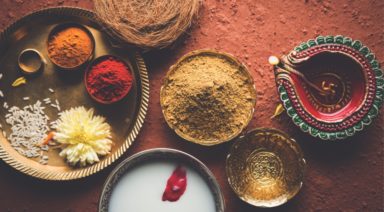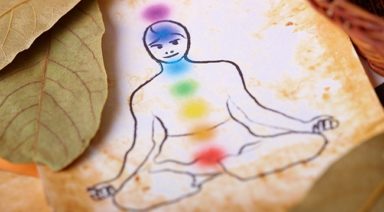The Legend of Garuda; Half-Man, Half-Bird

Chances are, if you’ve ever found yourself on your yoga mat, you may have experienced Garudasana, or Eagle Pose. Many are unaware of the origins of the yoga pose, or the story behind the legendary Garuda. I love Garuda because I went to high school in Jakarta, Indonesia, and the main airline in those days was called Garuda Airlines. I also remember seeing many statues of Vishnu in Bali riding on top of his trusty friend, Garuda. I soon became infatuated with the stories of Garuda and what he exemplifies for us as yogis.
Garuda, half-man/half-eagle, was the vehicle for Vishnu. Vishnu is known in Hindu mythology as “The Protector” or “The Sustainer” and is one of the Holy Trinity. The Holy Trinity consists of Brahma (Beginnings), Vishnu (Middles), and Shiva (Endings). The beginnings, middles, and endings represent the eternal ebb and flow of all of our experiences. We soon learn they are the only constant in an ever-changing world. Vishnu as The Sustainer is much like our breath that sustains our life. He is also the love that sustains our souls.
Garuda was known for his propensity for eating poisonous serpents. The full yoga posture binds the arms and legs around one another and provides compression. Once any compression posture is released, we generally experience a fresh new outlook and energetic exchange. Garuda loved to eat poisonous serpents for his meals. His body knew how to transform the serpents into nutrition in order to feed, sustain, and nourish himself.
When Garuda was first born he was massive. The egg he hatched from was enormous, and his wingspan was unlike anything any deity had ever seen before. The other deities were very intimidated by his size and knew he would grow even larger over the year, so they huddled together and came up with a plan. They asked Garuda to make himself smaller. Because Garuda was new to the community, he acquiesced. Being a newborn, he didn’t want to offend anyone. He also wasn’t so proficient at standing up for himself yet. But he did realize that even though his frame was smaller, he still had a bigness of spirit. He promised himself he would always let his spirit shine as big as he could.
Once when Garuda was young, he received a message his mother had been kidnapped and was being held hostage by evil forces. The note claimed the only thing that would save his mother, and return her safely to his home, was the nectar of the gods, or Amrita. Garuda knew the nectar was located on top of a big mountain in the vicinity, and also heard rumors of a few challenging obstacles to overcome that were placed specifically along the route to help protect the nectar from thieves.
The first obstacle he came across was a passageway he needed to fly through. But the passageway was filled with spinning and swirling sharp knives. He paused mid-flight, assessed the situation, and came to a quick and effective conclusion. He realized he needed to be adaptable, so he momentarily shrunk himself into a small speck in order to fly through the tiny hole in the middle of all the spinning knives without getting harmed. Grateful that he was used to shape-shifting from the moment he was born, he easily passed through.
Onward and upward he flew, and around the corner, he encountered the second obstacle; a second passageway came into view, highlighted because it was filled with searingly hot flames. The flames were dancing and frolicking and impeding any ability for Garuda to get through the middle. Garuda started sweating, and frantically looked around. He saw a nearby river gurgling and ebbing and flowing. Suddenly he had an idea—he turned himself back into a gigantic bird, filled his mouth with as much water as he could manage, and sprayed the flames. He was able to spit enough water over the flames, momentarily dousing them. This allowed him to fly through, conquering obstacle number two.
For some moments, the serpents were blinded by the chaos Garuda’s wings caused. Once their eyes closed, they forgot to spit venom. Garuda saw his chance and flew past them to retrieve the nectar and eventually save his mother.
In diminishing himself in size, Garuda reminds us that no matter how small we make ourselves, no matter how much we constrict and bind our body, we still have inside of us a bigness of spirit. Many of us deal with injuries, anatomical issues, and muscles that are tight. But Garuda teaches us that no matter how limited we may physically feel, we must find ways to shine our light and to practice being unapologetically true to who we really are. Our potential is boundless just like our spirit energy.
Garuda also exemplifies how to be flexible in body, mind, and spirit. He knows how to stay disciplined and focus on the task at hand. He knows how to remain open to learning how to adjust and shapeshift himself for what is being required of him. It’s easy to get caught up in the yoga scene and wish we had that perfect posture or the perfect body to perform the posture, but the true yoga practitioner learns how to work with what they have. And as we learn to love ourselves more and accept ourselves in bigger and better ways, we begin to spread our wings and fly.
Ridding Your Negative Personal Narratives With Lord Shiva

Lord Shiva is a well-known and worshipped Hindu deity. He is one of the Holy Trinity (the Trimurti), which consists of Lord Brahma, Lord Vishnu, and Lord Shiva. What each represents in our familiar terms are brand new beginnings (Brahma), the middle of everything in existence (Vishnu), and the endings (Shiva). When Shiva, as the Lord of Dissolution, gives us the endings, he also provides the space for Brahma to instill a bright new beginning. It is from the void of nothingness, or space, left after something comes to an end, that Brahma responds by bringing the start of something new.
Shiva, Lord of Dissolution
Shiva, The Auspicious One, is also known as Mahadeva or The Great God. He is worshipped as the Supreme Being in Shaivism, a major institution within Hinduism. I like to explain the concept of endings giving way to brighter new beginnings with the metaphor of a bookshelf filled with storybooks that represent our own considerations about ourselves.
Imagine you have a large bookshelf in your mind. The bookshelf is jam-packed with books whose titles represent your own self-judgments or concepts of yourself. One thing to mention is that we are constantly in judgment of ourselves. We are usually in judgment of something and judgments can be good or bad. For instance, we might see a book entitled ‘I am a great Mother,’ or ‘I am a giving person.’
Conversely, we have the debilitating narratives. ‘I am unworthy’ or ‘I am not flexible enough’ as some of the titles we’re experiencing. But the debilitating narratives are simply opportunities to grow or bring Shiva into our lives.
Shiva comes along as the Lord of Dissolution; he shows us where we are hindering our growth with certain stories or ways of being. For instance, when you decide you are fed up with thinking of yourself as unworthy, or not good enough, Shiva gives you the willpower to dissolve that story. The ‘I am unworthy’ book gets removed from the shelf and thrown to the wayside.
What is left behind is an open space, an open space ready and willing to house a new book with a new title. Brahma steps in and gives us the capacity to formulate a new storybook title that feels brighter and shinier as a new beginning, or judgment of self. For example, we switch from the ‘I am unworthy’ mantra to ‘I am good enough.’ In this way, Shiva and Brahma give us the ability to challenge our belief system and change it for self-betterment.
Shiva, Lord of Dance
A common depiction of Shiva is one of a dancing four-armed deity. In this form, Shiva is known as Nataraja, or the Lord of Dance. He is seen dancing in a halo of fire which represents samsara, or ‘flowing around.’ In his upper right hand, Shiva holds a hand drum said to have drummed the first drum beats to help create everything, paired with the sound of “Om.”
His upper left hand holds a flame said to have the ability to destroy on behalf of transformative new beginnings. His bottom lower right hand holds abhayamudra, a gesture used to convey fearlessness. His bottom left hand mimics the lifted position of his left leg. This symbolizes a respite soul’s find from the earthly troubles on a path towards soul liberation. His lifted left leg is a journey towards this elevated consciousness. Finally, the snake he wears around his waist is the creative energy that exists in our psychic body.





































